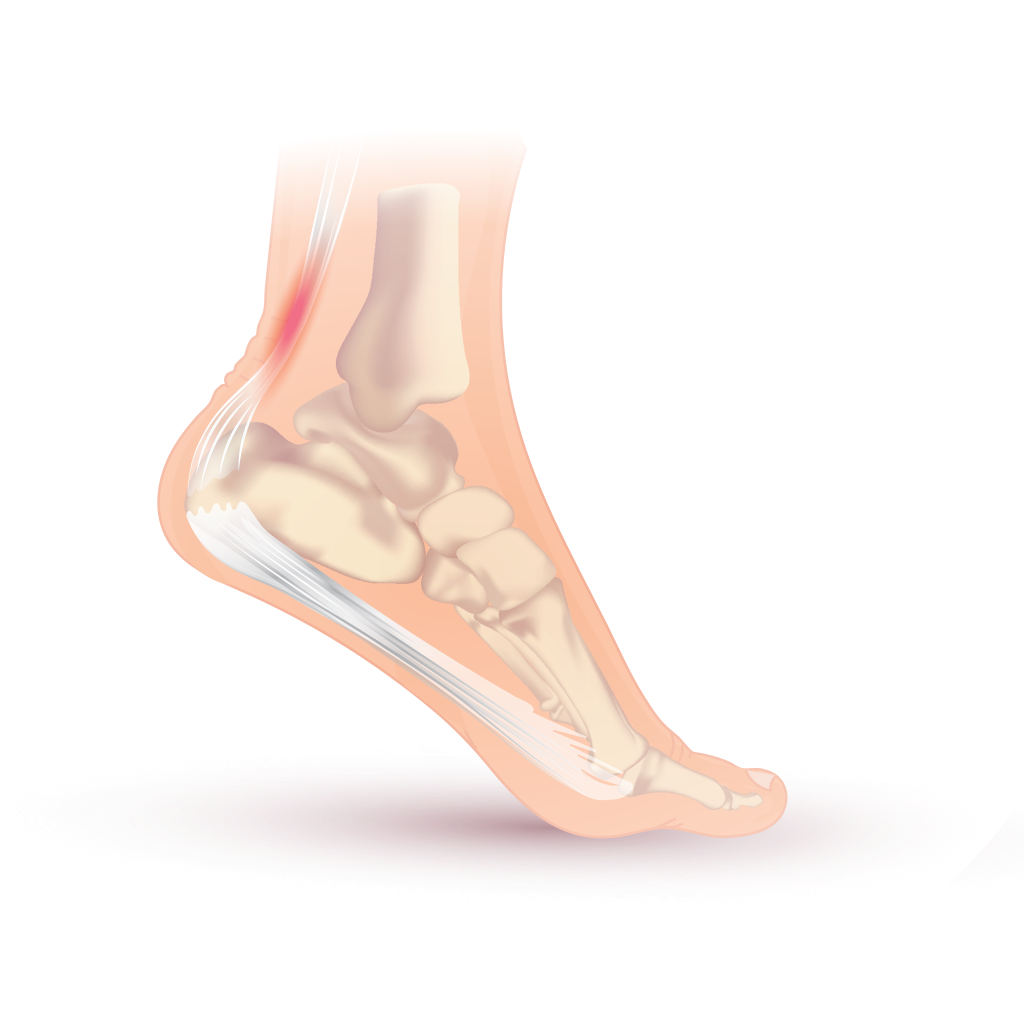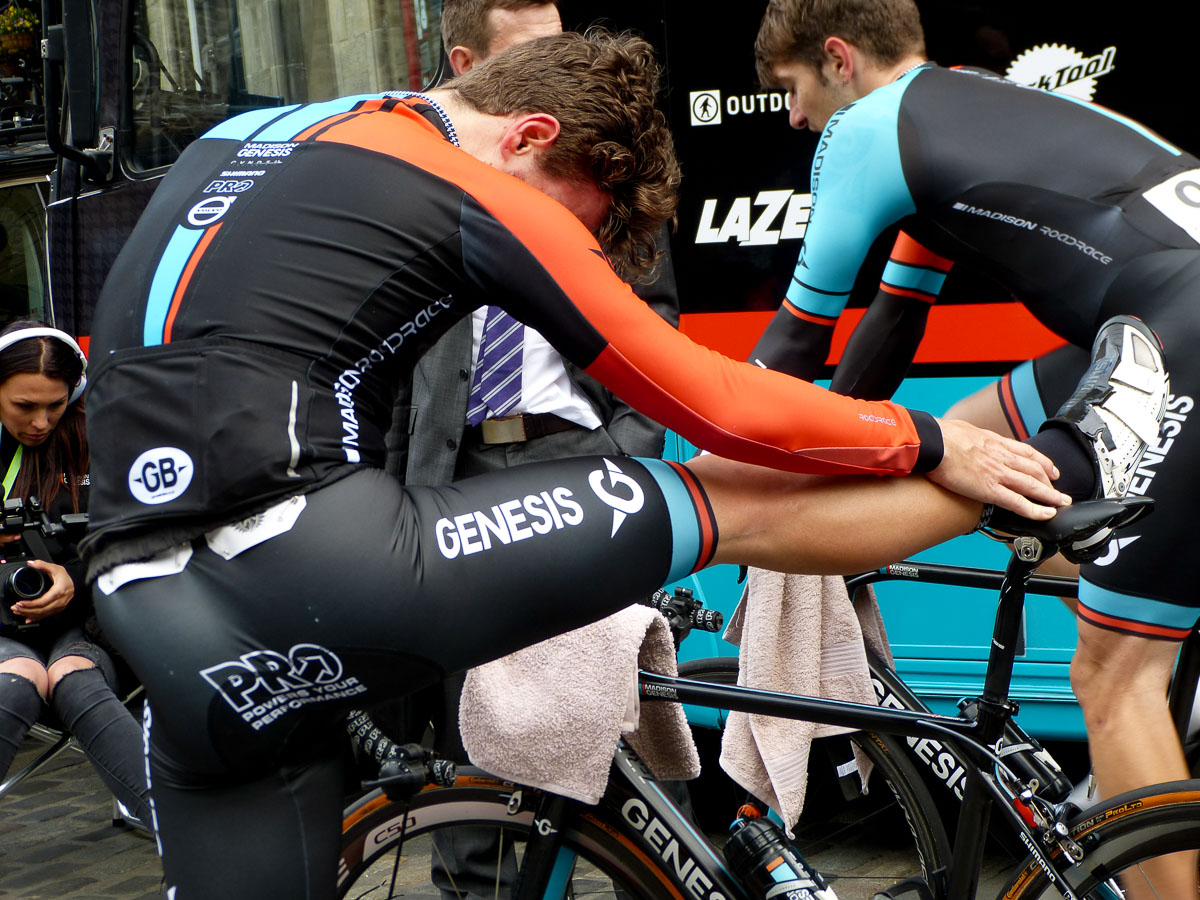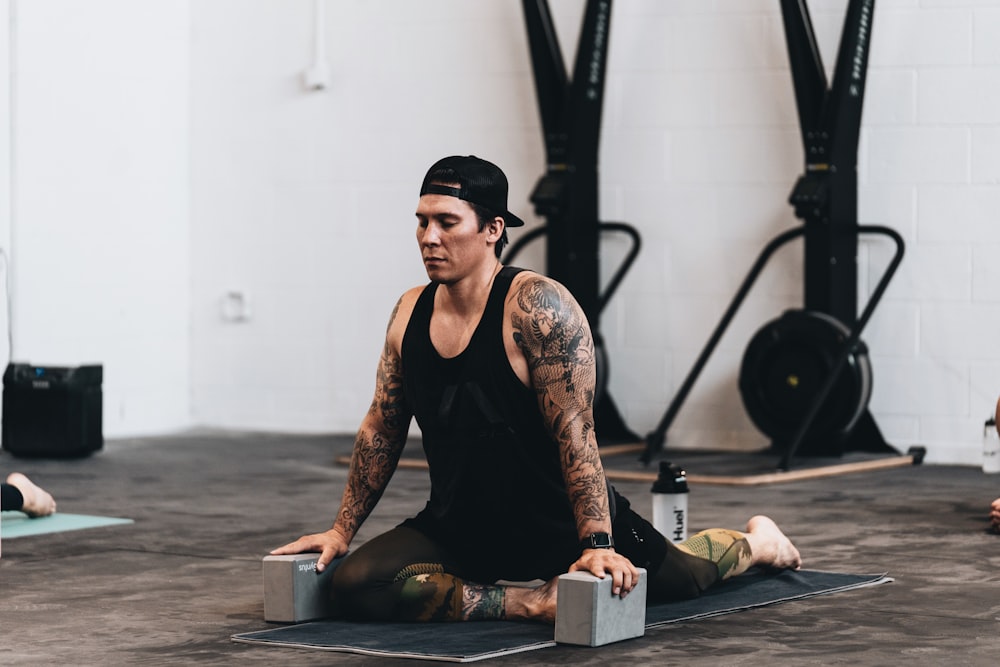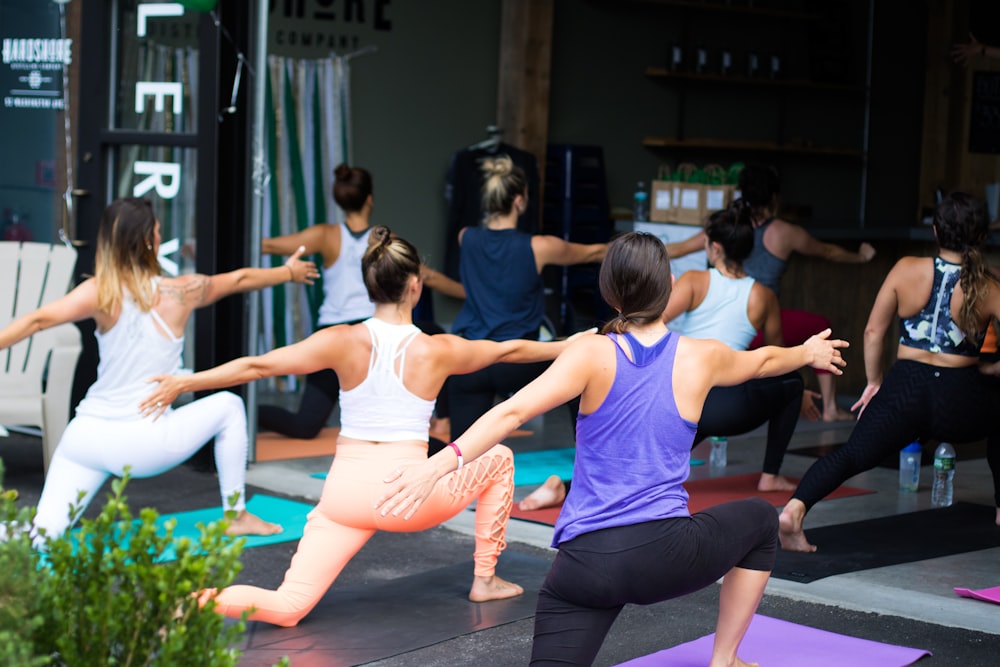Injury Prevention & Rehab for Cycling
Taking part in any sport or exercise brings with it the risk of injury, and cycling is no different.
It is common for cyclists to jump straight on the bike when going for a ride, whether it’s just a casual ride, a training ride, or even an amateur competition, without ever thinking about preparing the body for exercise.
The same can be said about post ride; many get off the bike after a strenuous ride and go about the day as if nothing ever happened.
This approach can work for some lucky individuals—mostly younger cyclists—but it is likely to cause problems as the months and years add up, giving rise to mobility issues, overuse injuries, and imbalances.
Cyclists need to take care of their bodies no matter their level, but the more cycling you do, the more time you should devote to taking care of your body.
Some people will ask, “How can I prevent injury while cycling?“. You can avoid many injuries by having a professional bike fitting and doing some careful pre-and post-ride care. However, if you cycle regularly, encountering an injury or painful area is inevitable but a worthwhile trade-off for our wonderful hobby.
This article will highlight common issues and injuries experienced by cyclists, methods of prevention and rehab, and provide activities you can try before and after your ride.
What Are the Main Benefits of Cycling
There is a risk of injury associated with cycling, like any physical activity. However, let’s not forget the numerous physical and mental health benefits of riding your bike.
Muscle development
Cycling is an excellent way to develop the muscles in your legs, primarily your quadriceps muscles, calf muscles, and glute muscles. Strengthening these muscles will benefit many aspects of day-to-day life, whether participating in physical activity or not.
Cardiovascular system
Cycling, especially moderate-intensity cycling, strengthens the heart, blood vessels, and lungs. In addition, your body’s natural ability to adapt to stress (exercise) means you make positive changes to your body, increasing the efficiency and strength of each system you use.
Weight loss
For anybody interested in losing weight with the help of exercise, riding a bicycle is a fun and effective way to do it. Cycling at any intensity will burn calories, and increasing the duration you spend on the bike will help contribute to weight loss.
When using exercise to lose weight, the most important consideration is choosing something you enjoy. If a bike ride meets that standard for you, it can be incredibly rewarding for your physical and mental health.
Mental & social benefits
Mental and social health are very closely intertwined, and physical exercise, especially with others, is a great way to achieve some of those benefits. For example, exercise reduces stress and anxiety, eases the symptoms of depression, and improves self-esteem.
Improved social connection or a sense of community is also linked to better mental and physical well-being, so joining a cycling group is a great way to make friends and bring added joy to the activity.
Common Cycling Injuries & Reasons
Seeking the help of a trained physiotherapist to diagnose any sports-related injury is always the best practice. Symptoms often stem from issues up or downstream of a pain site. For this reason, muscles, bones, and connective tissues need to be considered interconnected systems, where one impact or imbalance can cause ripple effects in other locations.
The best way to avoid pain and injuries from cycling starts from the beginning is ensuring you purchase and ride a bike for your height.
It is also valuable to have a fitting done with a professional to ensure your handlebars, saddle, and seat height (among many other areas) are set correctly.
Check out our article on sizing to help you choose the perfect fit for your next bike.
Knee injury or pain
Cycling knee pain is one of the most common problems encountered. The pain is often due to a poor saddle or cleat position, which results in extra pressure on the joints or a repetitive motion in a poor position. Pain can also arise from overtraining or overuse.
An excellent example of the connectedness of tissues is IT Band Syndrome (ITBS). With ITBS, pain and inflammation usually manifest on the outside of the knee. However, the problem often stems from tightness at the hip insertion or a muscle imbalance in the glutes.
Cycling Knee Pain — Understanding and Fixing the Most Common Causes
There are many sources online that offer guidance to riders when setting up their bikes without the help of a professional. For example, see proper cleat setup and setting saddle height from Specialized’s bike fit team in California to help avoid these problems. The use of insoles is also a tactic for tackling recurring knee pain. At times, simply reducing the load (time spent cycling) is enough to alleviate the problem.
When pain is not associated with fitting, riders may require mobility and strength exercises for the hips and glutes to target the root of the pain. A physiotherapist will be able to offer a series of activities with appropriate progressions for your body to help address these injuries.
Lower back pain
Spending hours in the saddle, especially in more aggressive positions (road bikes), is likely to cause some issues when added to typical daily activities such as sitting at a desk for work, watching TV, or eating throughout the day. Tight tissue systems, poor posture, and inactive or weakened core muscles build up during day-to-day life, and the problems these weaknesses can cause are exacerbated from hours of sitting on a bike.
Ensuring your bike fits correctly will help alleviate lower back pain because a poorly positioned handlebar stem or the wrong frame size can lead to overreaching and overextended lower back. In addition, adding abdominal strengthening exercises to your routine is valuable for both daily life and cycling performance. These activities can help reduce back problems and improve the power of your entire trunk system.
Lower Back Pain from Cycling — Causes, Treatment, and Tips for Prevention
Working on tissue mobility of the lower back muscles, the mid to upper back, and the glutes and hamstrings can relieve some symptoms. However, a physiotherapist may need to develop a personalized strengthening routine to fix the cause of the problem if it is recurring.
Walking is an excellent active recovery strategy for back pain, and walking regularly throughout the day is something we should all be doing to balance our time spent sitting. If it is necessary to take a break from cycling to help with lower back recovery, it is important not to replace it with more sitting, which will delay your recovery and contribute to the problem.
Achilles Pain (Ankle)

Image source: wikipedia.org
The Achilles tendon connects the heel to the calf muscles, and it is another common injury or pain point experienced by cyclists. Tightness in the areas above and below the tendon can cause excess pulling on the tissue and pain. Poor foot positioning (too far forward or backward) may also contribute to tendonitis.
Firstly, it is always best to have your bike fitted correctly to rule that out as a possible contributor to any injuries. Overtraining or increasing training load too quickly are also common causes of Achilles injuries, so taking more time to rest between rides, or doing shorter sessions to strengthen the area before progressing, could be sufficient to fix the problem. This problem should be treated quickly to avoid the possibility of chronic pain so if it persists, seek the help of a professional.
Hands & wrists
Extended time in the saddle can lead to pain in the hands and wrists, especially on flat handlebars, since there are fewer positions available to grip the bars than drop bars.
Changing your hand position frequently during a ride is important for relieving the pressure on the joints. Additionally, you can purchase bike gloves with padding to reduce pressure on the hands.
Riding with a slight bend at the elbows acts as a shock absorber for any impacts or rough surfaces. If your bicycle is too small, you may be putting excess pressure on the handlebars, so having the right size frame that’s adjusted to fit you ensures your weight is distributed correctly between the saddle and handlebars. Proper weight distribution gives your body the best chance of preventing this injury. If pain persists, decrease time spent riding and seek the help of a medical professional.
Neck pain
Many hours spent riding can cause the neck muscles to shorten, leading to pain in the neck or upper spine. This pain is typically due to overtraining or poor positioning on the bike. Raising your handlebars slightly and creating a less aggressive riding position can help with neck problems. Visit your doctor or physiotherapist if you have persistent neck pain in the days following a ride.
Rest, heat, and some gentle neck mobility exercises can help alleviate some of the discomfort experienced after a long ride. However, an unusually long ride or coming back after some time without riding is likely to cause discomfort as the body has lost its conditioning.
Stretching vs Mobilizing
Stretching is just one component of any mobilizing routine. Mobilizing includes soft tissue work using the hands or tools such as a massage ball or foam roller to improve tissue stiffness and sliding capabilities.
Active stretching focuses on movement through different positions with breath connection to increase tissue length. Activities include yoga and passive stretching.
Static stretching (stretching in one position to lengthen muscles) is ineffective for warming up, producing no performance benefits or injury risk reduction.
A specific ‘dynamic’ warm-up is done through moving in and out of end-range positions by targeted muscle contractions at the end range or with fluid movement and focused control, both warming up the body and opening up the joints and muscles for exercise specific activities.
Pre-ride
Priming your body for movement is essential no matter what sport or exercise you do. Warming up increases blood flow and raises body temperature, which improves the range of motion in the joints and muscles.
The effects of a targeted warm-up help prevent injuries and improve performance. There are many exercises for warming up, but for this article, we will identify the four muscles and joints which will provide the bulk of the value when mobilizing for a ride.
These exercises can be repeated two to three times in a circuit, with 10 to 15 repetitions for each exercise. Consult your doctor or physiotherapist before trying any new exercise routine to avoid issues with any current or underlying condition.
Glutes
Much of the power generated for cycling comes from the glutes, mainly the gluteus maximus, one of the largest and strongest muscles in the body. Functions of the glutes include stabilization of the pelvis, supporting the hips, and protecting the lower back. Warming up the glute muscles before a ride will help activate the area and allow them to carry out these vital functions effectively.
The glute bridge exercise with an isometric hold is an excellent way to activate the glutes for your ride. This exercise also helps with core activation and stabilization.
Hips
Because we spend a large percentage of our waking hours sitting (a closed position for the hips), we inevitably have tight anterior (front) hips, further accentuated by the time spent sitting on the bike. For this reason, cyclists benefit from opening up their hips both before and after a ride to avoid hip impingement and help generate maximum efficiency for the ride.
Check out this hip-opening exercise, which can be done in variations with or without the band, helping you open the hip while also activating the glutes.

Image source: cxmagazine.com
Thoracic (mid) spine
Mobilizing your thoracic spine has great secondary benefits for your neck and lower back, creating more space in the chain and allowing for a more comfortable ride with less risk of strain. Additionally, a dynamic warm-up in this area will pay dividends for your enjoyment and performance while riding.
This lying thoracic opener is a great dynamic exercise to prime the t-spine for activity and teaches core activation throughout the upper back movement.
Abdominal muscles (core)
Your core muscles provide stabilization throughout the body for almost every movement you do. As a result, an active and effective core musculature translates to improved efficiency of the whole system. This results in improved balance, increased power through enhanced energy transfer, and a lower chance of injury due to better organization and control of the body’s systems.
The ‘dead bug’ exercise is an excellently targeted core activation exercise, with the benefit of keeping the lower back in a supported position.
Post-ride & rest days
Spending some time mobilizing your body after a ride will keep injuries at bay while also improving the day-to-day function of your muscles and joints. To get the maximum benefits for injury resilience and performance, include some mobility work into your daily routine or at the end of each workday before you sit down to relax.
Work on the same primary muscle groups targeted pre-ride when mobilizing post-ride, adding other areas to your daily routine to help maintain good all-round mobility. There are dozens of exercises with different variations, but here are three mobilizations with a high return on investment.
The couch stretch
The couch stretch opens up your hip flexors and quads, tightening and shortening during cycling. This stretch may help prevent injuries and improve performance for your next ride while also counteracting some of the adverse effects of sitting.
The variation in the link above, which includes isometric contractions, also strengthens the brain’s connection to the glutes with glute activation through movement and conscious breathing.
Elevated pigeon

Try the standard pigeon pose as well.
A take on yoga’s pigeon pose, the elevated pigeon, allows less flexible individuals to get the benefits of the position. The stretch targets the back of the hip, glutes, and front of the hip on the non-elevated leg.
Pigeon is an excellent position to spend some time passively, freeing up the hands to hold a book and read, catch up on some emails, or watch your favorite TV show.
Lower back & hamstring opener
Lying on your back with your legs flat against the wall is a popular way to achieve a well-supported position to open your hamstrings and lower back with a supported lower back. It also helps to prevent blood pooling in the legs following a long ride, making the joints and muscles of the legs more mobile.
An excellent way to improve the effectiveness of this position is to introduce a lacrosse or tennis ball by lying on the ball and slowly moving it around the lower back muscles and upper glute muscles. Doing so creates extra pressure, which helps to release tight or ‘knotted’ tissue, similar to a deep tissue massage.
Sleep and Nutrition for Recovery
To learn more about nutrition for performance and recovery, check out our cycling nutrition article.
Sleep is fundamental to injury prevention, rehabilitation, and general performance both on and off the bike. Getting enough rest in the form of 8 hours of sleep a night improves athletic performance and reduces the risk of injury.
Sleep deprivation, or lack of sleep, reduces cognitive ability and reaction times, meaning a greater possibility of an accident on the bike. To give your body the best chance at recovery, make sleep your number one priority when injured or training for competition.
To learn more about the power and importance of sleep, check out UC Berkeley’s Dr. Matthew Walker’s TED Talk or his book ‘Why We Sleep.’
Massage, massage balls, and foam rolling
Massage is widely used in professional sports as it has been shown to aid recovery by improving muscle soreness induced from exercise (DOMS) and increasing mobility.
Massage increases blood flow and hydration to the worked area and frees up tight muscle tissue and myofascial networks that can restrict movement if not appropriately addressed following exercise.
For most cyclists, getting a massage regularly after a ride is not practical. However, using a foam roller or lacrosse ball can help us recreate the positive changes that a trained sports massage therapist aims to derive from deep tissue massage therapy.
Once you know what you are doing, it is easy to take a lacrosse ball or roller and incorporate some soft tissue work into your daily routine.
Many free online resources can teach you how to use these tools in different and creative ways. However, the quality of these resources varies greatly, so learning how to do it correctly will make a big difference in how much benefit you see from your time.
The Ready State channel by Kelly Starrett on Youtube has many great videos on improving mobility in different areas of your body with or without these tools. Also, it offers a ‘Virtual Mobility Coach’ app service to those who want to go deeper into these techniques.
Yoga for Cycling
Yoga is an excellent way for cyclists to supplement their exercise routine while also counteracting some of the imbalances resulting from the hours spent in one position, whether in the saddle or at a desk.
Another aspect of yoga is connecting breath to movement, which complements the benefit of more supple joints and muscles. Improving breath control and depth during exercise is a fundamental benefit of yoga that translates to all exercise and physical activities.
Yoga International has a short routine that is tailored for cyclists on its website. You can also practice by following any of the hundreds of free videos online or by joining a local class. With the popularity in recent years, thousands of studios and teachers are available across the US.
Conclusion
Whatever you do to improve your chances of staying injury-free and improving performance, it is essential to consult with a medical professional first.
Finding the time to ride can be difficult for many people, so incorporating injury prevention and mobilization into your routine may seem impossible. However, if you are creative with your time and squeeze in one or two minutes of mobilization here and there, the benefits add up quickly. These benefits can go a long way to preventing injuries and improving your performance on the bike and in your everyday life.












I am looking for information about multi-day bikepacking on paved roads
Hey Joseph, feel free to check out our bikepacking-related articles where we talk at length about it:
https://bikexchange.com/bikepacking-vs-bike-touring/
https://bikexchange.com/bikepacking-essential-tips/